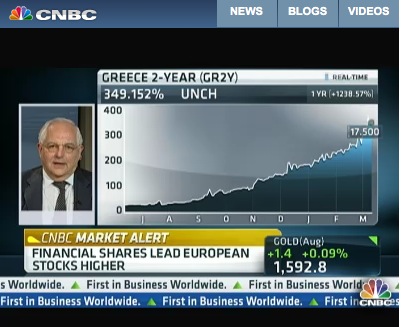
Martin Wolf appeared on CNBC today, which is never a good idea. Between all the swishing noises and flashing graphics, it was pretty hard to understand what he was saying — and in any case, the questions from Andrew Ross Sorkin were generally of the form “tell me what’s going to happen in the future”, rather than “analyze what we know about the present”. At one point Sorkin literally asked Wolf to “handicap the outcome” of the Greek election. Wolf is a fascinating and erudite man, and I’ve never had a conversation with him where I didn’t learn a lot. But maybe if I asked him that kind of question, it could be possible for me to walk away none the wiser about anything.
Ryan McCarthy picked up on one point that Wolf made: he said — or seemed to say — that a eurozone deposit guarantee scheme would not protect deposits against the risk of devaluation. Sorkin really should have pushed him on this, since it seems to me at least that the whole point of a eurozone deposit guarantee scheme would be to keep depositors whole in euro terms, even if their country leaves the euro and devalues. Even without such a scheme, there’s a strong case to be made that if and when Greece leaves the euro, the EU should essentially write a large check to Greek depositors, making up for any losses due to the drachmaization of their deposits. Because if the EU doesn’t do that, capital flight from the European periphery will go from bad to catastrophic.
But CNBC is a place for heat rather than light, so instead of an interesting conversation between two smart journalists, we got shown the graphic above, twice. It purports to show a real-time quote for the Greek 2-year bond, which currently seems to be yielding 349.152%. (I love the idea that they know this number to three decimal places.) According to the chart, the yield on this instrument has been rising steadily until now: there’s no indication that there was even a dip after the bond restructuring in –
Hang on a sec. Check out that x-axis! You can’t be expected to grok this in the amount of time that the chart appears on CNBC — just a couple of seconds. But the chart stops in March, when the restructuring took place and the Greek 2-year bond ceased to exist. No wonder the yield is “unch”!
CNBC has more than its fair share of meaningless graphics, but this one is especially stupid: it’s a chart of an instrument which ceased to exist three months ago, showing what the yield on that instrument did in the run-up to its default.
Of course, CNBC’s viewers can’t be expected to understand that. The one thing they will understand is the yield, which is shown at 350%. CNBC is sending a clear message, here, that Greek debt is about to default, and it’s using a made-up measure to do so. There’s no such thing as the Greek 2-year bond yield, but Bloomberg has done its best to come up with an approximation of what such a thing might be trading at — and their best estimation puts the Greek two-year benchmark at 8.98%. Which means that CNBC is only off by a factor of, oh, 340 percentage points. Well done that channel! In any case, here’s the clip.
Felix Salmon is a financial writer, editor, and podcaster. A former finance blogger for Reuters and Condé Nast Portfolio, his work can be found at publications including Slate and Wired, as well as his own Substack newsletter.
